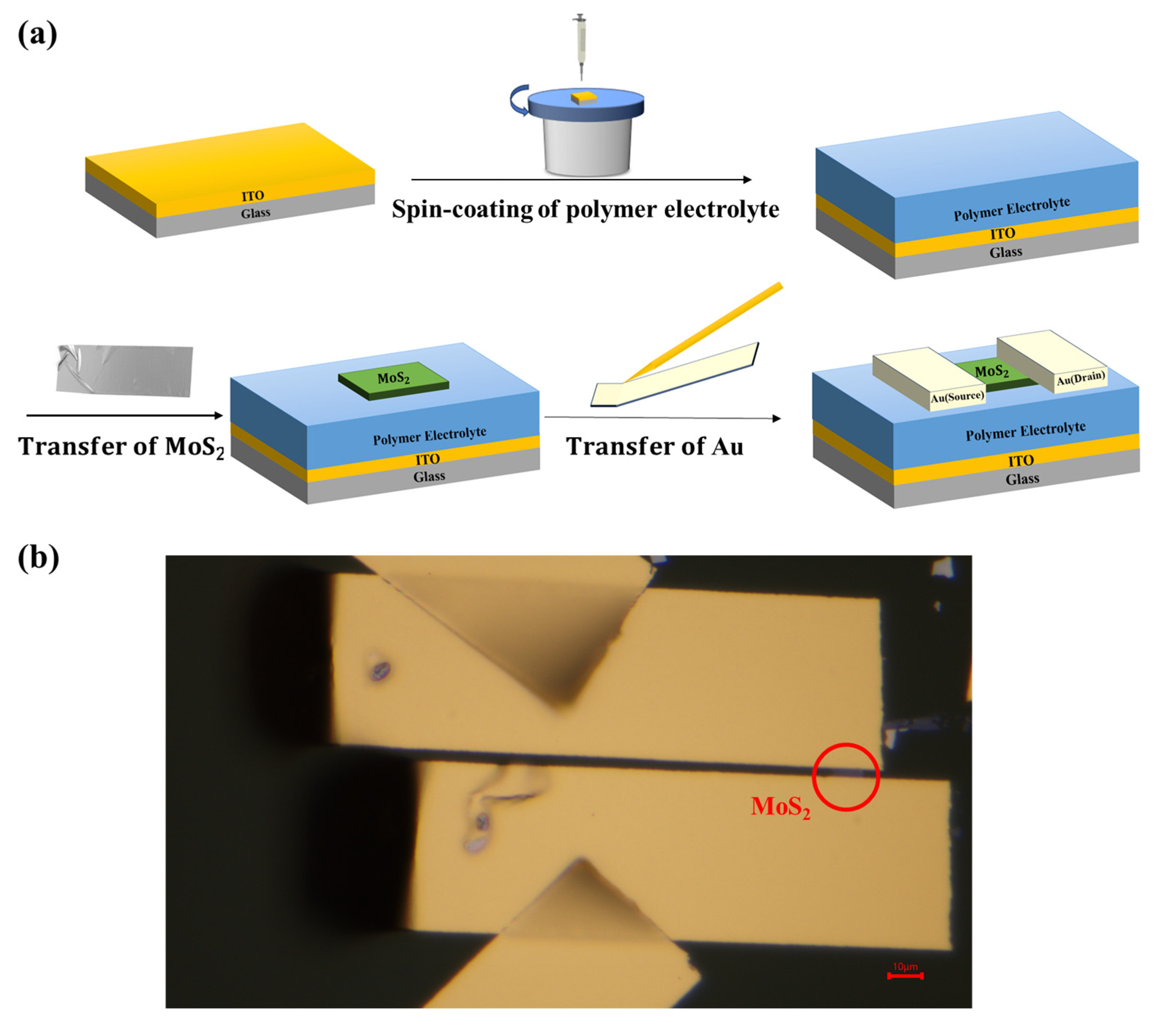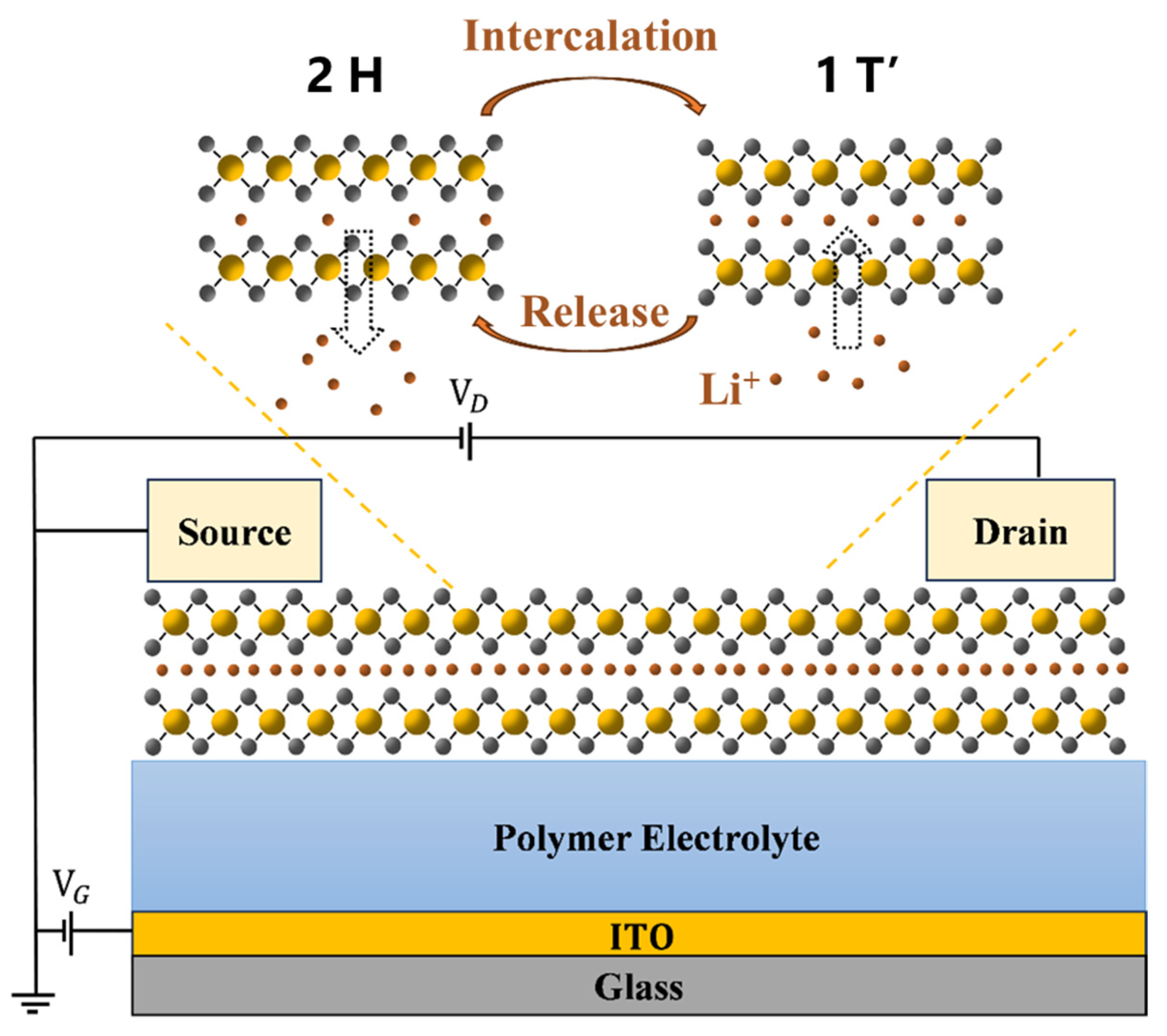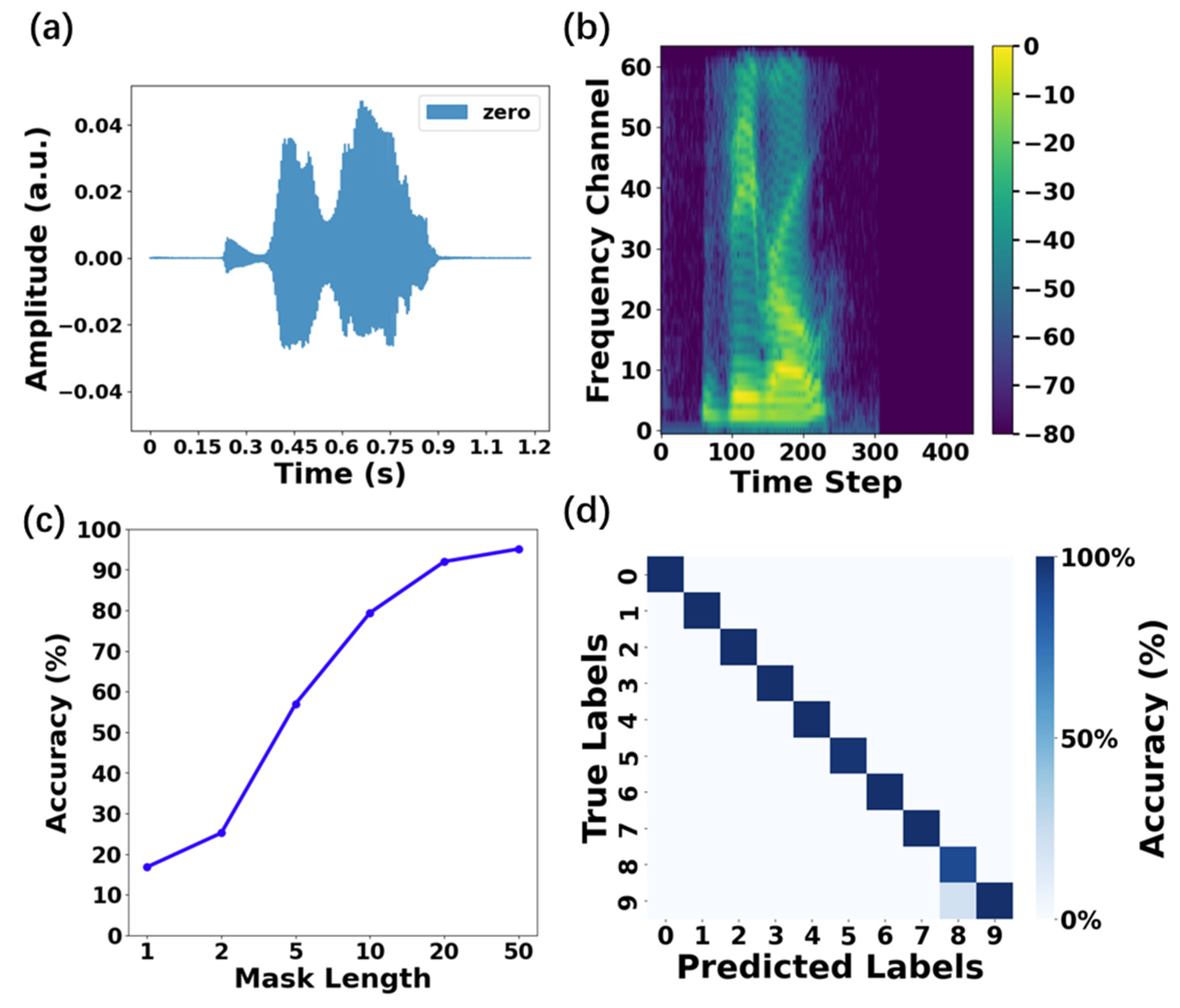Reservoir Computing Enabled by Polymer Electrolyte-Gated MoS2 Transistors for Time-Series Processing
Abstract
1. Introduction
2. Materials and Methods
2.1. Materials
2.2. Synthesis of Polymer Electrolyte Solution
2.3. Device Fabrication
2.4. Measurements and Simulations
3. Results
3.1. Operation Mechanism
3.2. Electrical Characteristics
3.3. RC System Based on Polymer Electrolyte-Gated MoS2 Transistors
3.4. RC System for Spoken Digit Recognition
3.5. RC System for Chaotic Time-Series Prediction
4. Discussion
5. Conclusions
Author Contributions
Funding
Institutional Review Board Statement
Data Availability Statement
Conflicts of Interest
References
- Appeltant, L.; Soriano, M.C.; Van Der Sande, G.; Danckaert, J.; Massar, S.; Dambre, J.; Schrauwen, B.; Mirasso, C.R.; Fischer, I. Information Processing Using a Single Dynamical Node as Complex System. Nat. Commun. 2011, 2, 468. [Google Scholar] [CrossRef] [PubMed]
- Yan, M.; Huang, C.; Bienstman, P.; Tino, P.; Lin, W.; Sun, J. Emerging Opportunities and Challenges for the Future of Reservoir Computing. Nat. Commun. 2024, 15, 2056. [Google Scholar] [CrossRef] [PubMed]
- Qi, Z.; Mi, L.; Qian, H.; Zheng, W.; Guo, Y.; Chai, Y. Physical Reservoir Computing Based on Nanoscale Materials and Devices. Adv. Funct. Mater. 2023, 33, 2306149. [Google Scholar] [CrossRef]
- Wu, X.; Lin, Z.; Deng, J.; Li, J.; Feng, Y. Nonmasking-Based Reservoir Computing with a Single Dynamic Memristor for Image Recognition. Nonlinear Dyn. 2024, 112, 6663–6678. [Google Scholar] [CrossRef]
- Moon, S.; Park, C.; Jung, Y.; Min, K.-S.; Ko, H.; Yoon, T.-S. Reservoir Computing Determined by Nonlinear Weight Dynamics in Gd-Doped CeO2/CeO2 Bi-Layered Oxide Memristors. J. Mater. Chem. C 2025, 13, 4894–4909. [Google Scholar] [CrossRef]
- Yang, X.; You, M.; Pang, L.; Du, B. Reservoir Computing Based on Memristor Arrays in Random States. IEEE Trans. Circuits Syst. I Regul. Pap. 2024, 71, 3256–3268. [Google Scholar] [CrossRef]
- Wang, L.; Zhang, Y.; Guo, Z.; Wu, Z.; Chen, X.; Du, S. Reservoir Computing-Based Design of ZnO Memristor-Type Digital Identification Circuits. Micromachines 2022, 13, 1700. [Google Scholar] [CrossRef]
- Ryu, H.; Kim, S. Pseudo-Interface Switching of a Two-Terminal TaOx/HfO2 Synaptic Device for Neuromorphic Applications. Nanomaterials 2020, 10, 1550. [Google Scholar] [CrossRef]
- Taniguchi, T.; Ogihara, A.; Utsumi, Y.; Tsunegi, S. Spintronic Reservoir Computing without Driving Current or Magnetic Field. Sci. Rep. 2022, 12, 10627. [Google Scholar] [CrossRef]
- Chen, Z.; Li, W.; Fan, Z.; Dong, S.; Chen, Y.; Qin, M.; Zeng, M.; Lu, X.; Zhou, G.; Gao, X.; et al. All-Ferroelectric Implementation of Reservoir Computing. Nat. Commun. 2023, 14, 3585. [Google Scholar] [CrossRef]
- Pei, M.; Zhu, Y.; Liu, S.; Cui, H.; Li, Y.; Yan, Y.; Li, Y.; Wan, C.; Wan, Q. Power-Efficient Multisensory Reservoir Computing Based on Zr-Doped HfO2 Memcapacitive Synapse Arrays. Adv. Mater. 2023, 35, 2305609. [Google Scholar] [CrossRef] [PubMed]
- Lin, Y.; Chen, X.; Zhang, Q.; You, J.; Xu, R.; Wang, Z.; Sun, L. Nano Device Fabrication for In-Memory and In-Sensor Reservoir Computing. Int. J. Extreme Manuf. 2025, 7, 012002. [Google Scholar] [CrossRef]
- Zhou, C.; Huang, Y.; Yang, Y.; Cai, D.; Zhou, P.; Lau, K.; Li, N.; Li, X. Streamlined Photonic Reservoir Computer with Augmented Memory Capabilities. Opto-Electron. Adv. 2025, 8, 240135. [Google Scholar] [CrossRef]
- Ismail, M.; Mahata, C.; Kang, M.; Kim, S. SnO2-Based Memory Device with Filamentary Switching Mechanism for Advanced Data Storage and Computing. Nanomaterials 2023, 13, 2603. [Google Scholar] [CrossRef] [PubMed]
- Sun, L.; Wang, Z.; Jiang, J.; Kim, Y.; Joo, B.; Zheng, S.; Lee, S.; Yu, W.J.; Kong, B.-S.; Yang, H. In-Sensor Reservoir Computing for Language Learning via Two-Dimensional Memristors. Sci. Adv. 2021, 7, eabg1455. [Google Scholar] [CrossRef]
- So, H.; Lee, J.; Mahata, C.; Kim, S.; Kim, S. Synaptic Properties and Short-Term Memory Dynamics of TiO2/WOx Heterojunction Memristor for Reservoir Computing. Adv. Mater. Technol. 2024, 9, 2301390. [Google Scholar] [CrossRef]
- Thomas, S.; Moolayadukkam, S.; Priyanka, K.P. Structural, Mechanical, and Electronic Properties of In-Plane 1T/2H-MoS2, 2H-MoS2, and 3R-MoS2. In Science and Technology of 2D MoS2; Late, D.J., Rout, C.S., Eds.; Materials Horizons: From Nature to Nanomaterials; Springer Nature: Singapore, 2024; pp. 55–64. [Google Scholar]
- Wang, L.; Xu, Z.; Wang, W.; Bai, X. Atomic Mechanism of Dynamic Electrochemical Lithiation Processes of MoS2 Nanosheets. J. Am. Chem. Soc. 2014, 136, 6693–6697. [Google Scholar] [CrossRef]
- Wu, L.; Dzade, N.Y.; Yu, M.; Mezari, B.; Van Hoof, A.J.F.; Friedrich, H.; De Leeuw, N.H.; Hensen, E.J.M.; Hofmann, J.P. Unraveling the Role of Lithium in Enhancing the Hydrogen Evolution Activity of MoS2: Intercalation versus Adsorption. ACS Energy Lett. 2019, 4, 1733–1740. [Google Scholar] [CrossRef]
- Tanaka, G.; Yamane, T.; Héroux, J.B.; Nakane, R.; Kanazawa, N.; Takeda, S.; Numata, H.; Nakano, D.; Hirose, A. Recent Advances in Physical Reservoir Computing: A Review. Neural Netw. 2019, 115, 100–123. [Google Scholar] [CrossRef]
- He, Y.; Ge, Z.; Li, Z.; Li, Z.; Liu, R.; Zhang, L.; Lan, L.; Yue, W.; Xie, Z. All-Polymer Organic Electrochemical Synaptic Transistor with Controlled Ionic Dynamics for High-Performance Wearable and Sustainable Reservoir Computing. Adv. Funct. Mater. 2025, 35, 2415595. [Google Scholar] [CrossRef]
- Islam, R.; Shi, Y.; de Oliveira Silva, G.V.; Sachdev, M.; Miao, G.-X. Volatile and Nonvolatile Programmable Iontronic Memristor with Lithium Imbued TiOx for Neuromorphic Computing Applications. ACS Nano 2024, 18, 22045–22054. [Google Scholar] [CrossRef] [PubMed]
- Ma, Z.; Ge, J.; Pan, S. Spiking Reservoir Computing Based on Stochastic Diffusive Memristors. Adv. Electron. Mater. 2025, 11, 2400469. [Google Scholar] [CrossRef]
- Wang, Y.; Cheng, X.; Chen, S.; Liu, M.; Lv, Z.; Zhu, X.; Jia, Q.; Wu, C.; Wang, L.; Zhang, X.; et al. Sodium-Enhanced Perovskite Reservoir for Photonic in-Sensor Computing. Nano Energy 2025, 138, 110830. [Google Scholar] [CrossRef]
- Oh, J.; Park, S.; Lee, S.H.; Kim, S.; Lee, H.; Lee, C.; Hong, W.; Cha, J.; Kang, M.; Jin, J.H.; et al. Ultrathin All-Solid-State MoS2-Based Electrolyte Gated Synaptic Transistor with Tunable Organic–Inorganic Hybrid Film. Adv. Sci. 2024, 11, 2308847. [Google Scholar] [CrossRef]






Disclaimer/Publisher’s Note: The statements, opinions and data contained in all publications are solely those of the individual author(s) and contributor(s) and not of MDPI and/or the editor(s). MDPI and/or the editor(s) disclaim responsibility for any injury to people or property resulting from any ideas, methods, instructions or products referred to in the content. |
© 2025 by the authors. Licensee MDPI, Basel, Switzerland. This article is an open access article distributed under the terms and conditions of the Creative Commons Attribution (CC BY) license (https://creativecommons.org/licenses/by/4.0/).
Share and Cite
Wan, X.; Yuan, Q.; Sun, L.; Chen, K.; Khim, D.; Luo, Z. Reservoir Computing Enabled by Polymer Electrolyte-Gated MoS2 Transistors for Time-Series Processing. Polymers 2025, 17, 1178. https://doi.org/10.3390/polym17091178
Wan X, Yuan Q, Sun L, Chen K, Khim D, Luo Z. Reservoir Computing Enabled by Polymer Electrolyte-Gated MoS2 Transistors for Time-Series Processing. Polymers. 2025; 17(9):1178. https://doi.org/10.3390/polym17091178
Chicago/Turabian StyleWan, Xiang, Qiujie Yuan, Lianze Sun, Kunfang Chen, Dongyoon Khim, and Zhongzhong Luo. 2025. "Reservoir Computing Enabled by Polymer Electrolyte-Gated MoS2 Transistors for Time-Series Processing" Polymers 17, no. 9: 1178. https://doi.org/10.3390/polym17091178
APA StyleWan, X., Yuan, Q., Sun, L., Chen, K., Khim, D., & Luo, Z. (2025). Reservoir Computing Enabled by Polymer Electrolyte-Gated MoS2 Transistors for Time-Series Processing. Polymers, 17(9), 1178. https://doi.org/10.3390/polym17091178





